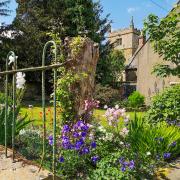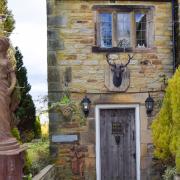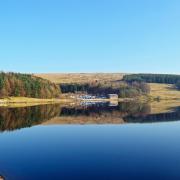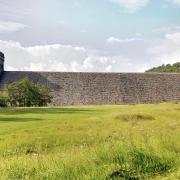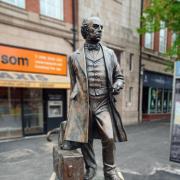As Heage Windmill celebrates a significant milestone, Ashley Franklin reveals why Heageans are rightly proud of their famous Derbyshire landmark
The village name Heage is of Anglo-Saxon derivation and means high, lofty and sublime.
This perfectly describes the village’s landmark attraction Heage Windmill, standing sentinel and proud as it presides over the spectacular verdant valleys of the mid-Derbyshire countryside.
In the January 2009 issue of Derbyshire Life, I wrote: ‘There is something about the shape, singularity and sheer nobility of a windmill that makes it one of the most prepossessing sights on Earth.’
A few days later, Heage Windmill Society member Alan Gifford contacted me to say: ‘We love what you said about our windmill - would you like to be a trustee?’
So began a fond, fixated relationship with the ‘old girl’ on the hill (‘all windmills are female,’ Alan points out).
When welcomed into the fold, I discovered the windmill looked as good as when first built in 1797 and that is due to the dedication, determination and drive of volunteers like Alan who are this summer celebrating the 20th anniversary of the windmill’s restoration.
Since 2002, this six-sailed stone windmill – the only one in the UK - has attracted visitors from Britain and beyond including, notably, a Derbyshire dame, culinary royalty and genuine royalty.

So high is visitor satisfaction that the windmill received Trip Advisor’s Certificate of Excellence for five consecutive years, earning a Hall of Fame award.
Furthermore, this windmill is no relic or museum: it’s a working windmill. Its flour, milled in the time-honoured way through the harnessing of the wind and grinding of the stone, is lauded for its fineness and its eminent suitability when it comes to baking bread. It can make the meanest of oatcakes – just ask the Hairy Bikers.
When built at the turn of the 19th century, the windmill was one of nearly 10,000 in Britain. In 1850, it was purchased by two brothers, Thomas and Isaac Shore. So began a dynasty that lasted nearly 85 years.
From 1919 however, storm and lightning damage plus erosion and neglect saw the mill experience fluctuating fortunes, leading to abandonment and dereliction.
1966 proved a turning point: when the owner’s application to convert the windmill into a house was turned down, the windmill became subject to a Building Preservation Order – the first ever recorded in the county – and the purchase of the windmill by Derbyshire County Council.
Much restorative work followed and when an open day was held in 1989 in conjunction with the Midland Mills Group, over 500 visitors came and the seeds of a full restoration were eventually sown, with 1996 seeing the formation of the Heage Windmill Society as a charitable trust.
One important cog in the wheel of the restorative process was founder trustee of the Society, Alan Gifford, who was instrumental in gaining the £350,000-worth of grants needed to fund the Society’s progress towards a fully-working windmill, even though Alan remarked that the filling in of application forms was ‘like taking a degree.’

Interestingly, Alan points out the greater availability of funding since the turn of the millennium has been a boon to heritage attractions: ‘Heage Windmill’s restoration happened, thankfully, at a time when the concept of industrial archaeology was gaining a strong foothold. Essentially, the Heage Windmill Society was one of many groups who decided old industries should not be swept away but regenerated, preserved and celebrated.’
Heage Windmill opened as a visitor attraction on June 1, 2002. Ever since, visitors have come to marvel at the elaborate system of cogs, shafts, pulleys, brakes, weights and trapdoors, all installed by diehard engineering buffs who then became the windmill’s millers and visitor guides.
Remarkably, every one of the 126 canvas shutters on the 30-foot-long sails was hand-sewn by these same volunteers.
Furthermore, to raise restoration funds, every shutter was sponsored by businesses and individuals, including many local residents, according to guide Monica Cooper, who lives in Heage: ‘I know Heageans are very proud of the windmill as it puts the village on the map. Sponsoring a shutter makes them feel invested in “their” mill.’
For Monica, a stint at the windmill is the ‘perfect antidote’ to her stressful occupation, working with victims of crime: ‘As I walk across the fields towards the mill, suddenly all is well with the world, knowing our team will give visitors a positive experience.’
It’s an experience that gives Monica a buzz every time: ‘I love everything about the windmill, with all its creaks, groans and fascinating tales.’

Monica often regales visitors with tales of the time mill apprentices ritually earned their ‘papers’ by being tied onto the sails and rotated. ‘Think of the view they would have had,’ smiles Monica, ‘as long as they were the right way up.’
Monica also reveals to visitors the origin of everyday expressions that came from windmills. For instance, as early millers had to check the grain between the stones was scorching, they had to sniff as closely as they dared, hence the saying ‘keep your nose to the grindstone.’
Monica loves to guide whilst milling is taking place – ‘the noise and surroundings make it feel as if we’re on board an ancient wooden ship’ – but her greatest thrill is the sheer satisfaction a tour gives visitors.
‘People are constantly amazed at the ingenious simplicity of the mill workings’ says Monica, ‘and families, especially children, love the interactive stuff like handling the pulleys or using a quern (a primitive hand mill) to grind the grain and sieve the flour in a miniature dresser. Better still, the sight of the sails flying past the window always produces “wows” from all around. I feel that same exhilaration myself.’
There have been many highlights over these 20 years, not least the tenth anniversary opening in 2011 by Dame Ellen MacArthur.
She amazed the crowd by revealing her familial connection to the windmill: she is a distant relative of the Shore family who owned the mill for 84 years.
This, in turn, gives the Dame of the Seas a bloodline to The Lady of the Lamp: Florence Nightingale’s father was also a Shore.
Also, it was heartening to hear the world’s most famous yachtswoman appropriately acclaim Heage Windmill as ‘a wonderful working example of something that harnesses the power of the wind.’

A few weeks later, Prince Edward became the first member of the Royal family to ever visit a tower windmill.
Chairman of the Heage Windmill Trust at the time, Piers Bostock, was instrumental in securing the Earl of Wessex’s visit.
As he recounted: ‘I found myself sitting to the right of HRH at a Buckingham Palace dinner party and he expressed an interest in visiting us.’
He also revealed the Prince so loves the windmill’s flour that Piers has replenished his stocks on several occasions.
Last November, Heage Windmill’s fame spread further through the visit of TV chefs Dave and Si - the Hairy Bikers.
In the Derbyshire episode of their BBC 2 series Go North, the culinary duo’s passion for traditional, locally-produced fare found rich food in their mill tour.
On camera, they described their visit as ‘heart-warming’, pronounced the stone-ground flour as ‘fabulous’ and ‘special’ and used it to bake scrummy Derbyshire oatcakes.
As webmaster for Heage Windmill, I felt the extraordinary impact of the Hairy Bikers’ TV show. In November, the website attracts an average of 50 visitors a day. In the week following the broadcast, we recorded over 12,000 visitors. Overnight, this local gem had become a national treasure.
Another TV celebrity, antiques expert Charles Hanson, will cut the ribbon on April 16 to officially herald Heage Windmill’s 2022 season, when the mill will be fully open for the first time since 2019.
The windmill will also host all its regular, popular event days featuring vintage tractors, classic bikes and American cars.

Behind this euphoria, however, lies unease. As maintenance manager David Land points out: ‘Any 225-year-old structure is bound to suffer from age-related deterioration.’
After successfully raising funds through the ‘Trouble at Mill Appeal’ in 2015 to replace two rotted sails, the dreaded wet rot has struck again, this time in the main structural beams which support the cap. ‘If not addressed,’ warns David, ‘the windmill may have to shut, permanently, for safety reasons.’
As a result, Heage Windmill has been placed on Historic England’s Heritage at Risk register. A fundraising campaign is nigh.
‘Such is the nature of windmills, this is another challenge to overcome’ says founder trustee Alan Gifford. ‘This will be a hard-fought battle but the old girl will survive. She must survive: Heage Windmill is an icon of this county and a wonder of this world.’
Heage Windmill officially opens April 2 and is open every weekend until the end of October. It is located off Chesterfield Road just to the north of Heage. Car parking is available free on site.




